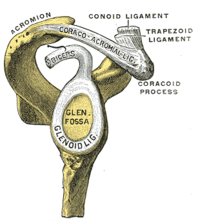
Photo from wikipedia
BackgroundMultiple published studies quantitatively analysing the diagnostic value of MRI, MR arthrography (MRA) and CT arthrography (CTA) for labral lesions of the shoulder have had inconsistent results. The aim of… Click to show full abstract
BackgroundMultiple published studies quantitatively analysing the diagnostic value of MRI, MR arthrography (MRA) and CT arthrography (CTA) for labral lesions of the shoulder have had inconsistent results. The aim of this meta-analysis was to systematically compare the diagnostic performance of MRI, MRA, CTA and CT.MethodsTwo databases, PubMed and EMBASE, were used to retrieve studies targeting the accuracy of MRI, MRA, CTA and CT in detecting labral lesions of the shoulder. After carefully screening and excluding studies, the studies that met the inclusion criteria were used for a pooled analysis, including calculation of sensitivity and specificity with 95% confidence intervals (CIs) and the area under the hierarchical summary receiver operating characteristic (HSROC) curves.ResultsThe retrieval process identified 2633 studies, out of which two reviewers screened out all but 14 studies, involving a total of 1216 patients who were deemed eligible for inclusion in the meta-analysis. The results assessing the diagnostic performance of MRI vs. MRA for detecting labral lesions showed a pooled sensitivity of 0.77 (95% CI 0.70–0.84) vs. 0.92 (95% CI 0.84–0.96), a specificity of 0.95 (95% CI 0.85–0.98) vs. 0.98 (95% CI 0.91–0.99), and an area under the HSROC curve of 3.78 (95% CI 2.73–4.83) vs. 6.01 (95% CI 4.30–7.73), respectively.ConclusionMRA was suggested for use in patients with chronic shoulder symptoms or a pathologic abnormality. MRI is by far the first choice recommendation for the detection of acute labral lesions. CT should be a necessary supplemental imaging technique when there is highly suspected glenoid bone damage.
Journal Title: BMC Musculoskeletal Disorders
Year Published: 2019
Link to full text (if available)
Share on Social Media: Sign Up to like & get
recommendations!